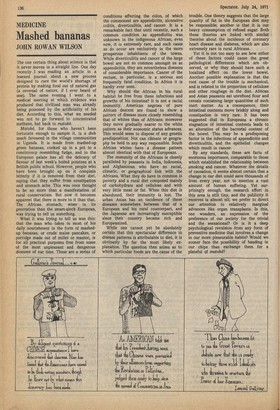MEDICINE
Mashed bananas
JOHN ROWAN WILSON
The one certain thing about science is that it never moves in a straight line. One day recently I was reading an article in a learned journal about a new process designed to cure the world's shortage of protein by making food out of natural gas (a reversal of nature, if I ever heard of one). The same evening I went to a medical meeting at which evidence was produced that civilized man was already being poisoned by the artificiality of his diet. According to this, what we needed was not to go forward to concentrated methane, but back to matoke.
Matohe, for those who haven't been fortunate enough to sample it, is a dish much favoured in the village communities in Uganda. It is made from mashed-up green bananas, cooked up in a pot to a consistency resembling fudge, and to the European palate has all the delicacy of flavour of last week's boiled potatoes at a British public school. However, people who have been brought up on it complain bitterly if it is removed from their diet, saying that they suffer from constipation and stomach ache. This was once thought to be no more than a manifestation of rural conservatism. But now it becomes apparent that there is more to it than that. The African stomach, wiser in its generation than the smart-aleck European, was trying to tell us something.
What it was trying to tell us was this: that the man who takes in most of his daily nourishment in the form of mashedup bananas, or crude maize pancakes, or porridge made out of millet or manioc, is for all practical purposes free from some of the most unpleasant and dangerous diseases of our time. These are a series of conditions affecting the colon, of which the commonest are appendicitis, ulcerative colitis, diverticulitis, and cancer. It is a remarkable fact that until recently, such a common condition as appendicitis was unknown in the indigenous African; even now, it is extremely rare, and such cases as do occur are exclusively in the more prosperous inhabitants of the towns. While diverticulitis and cancer of the large bowel are not so common amongst us as appendicitis, they are nevertheless diseases of considerable importance. Cancer of the rectum, in particular, is a serious and frequently fatal condition. In Africa it is hardly ever seen.
Why should the African in his rural habitat be free from these infections and growths of his intestine? It is not a racial immunity. American negroes of pure African descent are found to show a pattern of disease more closely resembling that of whites than of Africans; moreover they move gradually nearer to the white pattern as their economic status advances. This would seem to dispose of any genetic predisposition. Not can climate or geography be held in any way responsible. South African whites have a disease pattern almost identical with that of Europeans.
The immunity of the Africans is closely paralleled by peasants in India, Indonesia, and Afghanistan who have no racial, climatic, or geographical link with the Africans. What they do have in common is poverty and a rural diet composed mainly of carbohydrate and cellulose and with very little meat or fat. When this diet is abandoned, their immunity is lost. The urban Asian has an incidence of these diseases somewhere between that of a European and his rural counterpart, and the Japanese are increasingly susceptible since their country became rich and Europeanized.
While one cannot yet be absolutely certain that this .spectacular difference in disease patterns is attributable to diet, it is obviously by far the most likely explanation. The question then arises as to which particular foods are the cause of the trouble. One theory suggests that the large quanity of fat in the European diet may be responsible; another is that it is our heavy consumption of refined sugar. Both these theories are linked with similar theories about the incidence of coronary heart disease and diabetes, which are also extremely rare in rural Africans.
Yet it is not too easy to see how either of these factors could cause the great pathological differences which are observed, or why they should have such a localized effect on the lower bowel. Another possible explanation is that the root cause of the trouble is mechanical, and is related to the proportion of cellulose and other roughage in the diet. African and Asian peasants eat unrefined flour and cereals containing large quantities of such inert matter. As a consequence, their intestinal contents move briskly along and constipation is very rare. It has been suggested that in Europeans a chronic stagnation of intestinal contents leads to an alteration of the bacterial content of the bowel. This may be a predisposing factor in the infections of appendicitis and diverticulitis, and the epithelial changes which result in cancer.
By any standards, these are facts of enormous importance, comparable to those which established the relationship between smoking and cancer. Whatever the details of causation, it seems almost certain that a change in our diet could save thousands of lives every year, not to mention a vast amount of human suffering. Yet surprisingly enough, the research effort in this area is still tiny, and the publicity it receives is almost nil; we prefer to direct our attention to relatively marginal advances like organ transplants. Is this, one wonders, an expression of the preference of our society for the trivial and the sensational? Or is it a deep psychological revulsion from any form of preventive medicine that involves a change in our more pleasurable habits? Would we sooner face the possibility of handing in our chips than exchange them for a plateful of matoke?










































 Previous page
Previous page